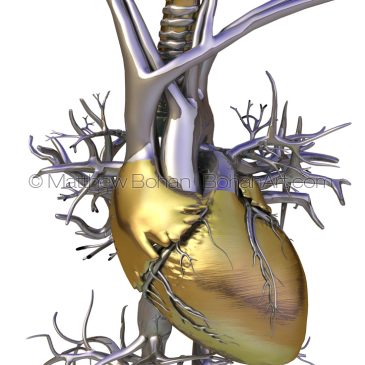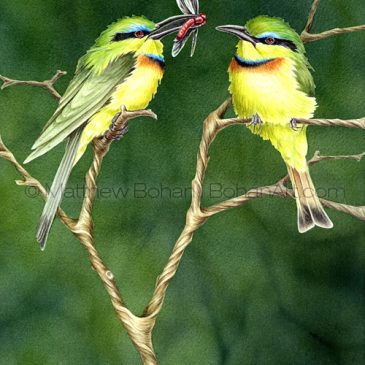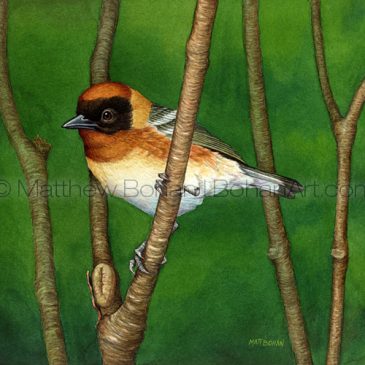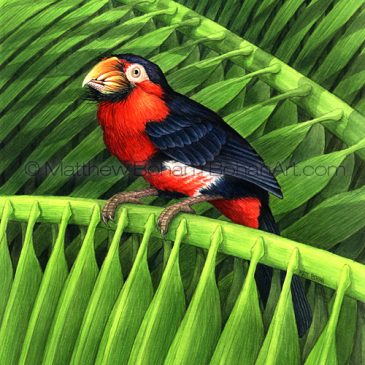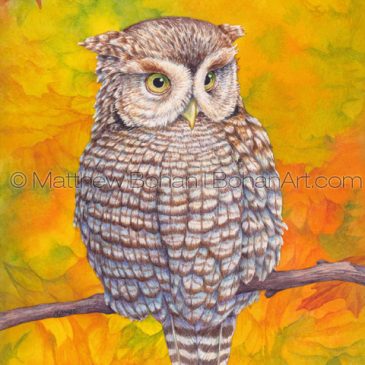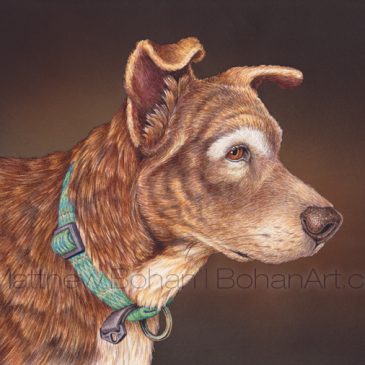Throwback Thursday: Bee Eaters!
Here are a pair of paintings from early 1997. I did the Little Bee Eaters as a wedding gift for my friend Mike. The Carmine Bee Eaters were an engagement gift for my (now) wife, Liesl. They were based … Continued
Throwback Thursday: Bay-breasted Warbler Transparent Watercolor
This small watercolor of a male Bay-breasted Warbler is from around 1998 or 1999. I did the painting based on photos of a cooperative male in Magee Marsh at Crane Creek, Ohio. Original painting is available here.
Cedar Waxwing Transparent Watercolor Time-lapse Video AND Step-by-step
Cedar Waxwings have been on the top of my wife’s request list for a long time. She has also been asking me to post a time-lapse video of a painting, so I did both on this one. … Continued
Throwback Thursday – Bearded Barbet Transparent Watercolor
This painting was especially fun to work on. I took numerous photos of Bearded Barbets at the Toledo Zoo. Images taken in zoos have their limits. Often the backgrounds leave a lot to be desired. After a lot of research, … Continued
Throwback Thursday – Extinct or Presumed Extinct Bird Paintings
I thought I’d compile all the illustrations of extinct or presumed extinct birds that I did a while back on one page. It is very sad to think they are all gone forever.
Eastern Screech Owl Transparent Watercolor Step-by-step
This drawing sat on the back burner for a long, long time before it made the transition into a painting. I did the sketches for this at the Royal Ontario Museum in 2000. That may be my all-time favorite natural … Continued
Mya: Mixed Breed Dog Step-by-Step Transparent Watercolor
It was fun to work on this commissioned painting. Mya is not only a very pretty dog, but she has an interesting back story. She was discovered in Mexico where she was living on the streets and “counting down her last … Continued
Grass-Carrying Wasp Pencil Sketch p67
There is no doubt about it, pain is an excellent teacher. Hornets, wasps and bees make for some vivid memories. Like many, I can still remember my first bee sting. It was in the clover of our backyard. Other stings … Continued
Throwback Thursday– Female Anhinga Transparent Watercolor
This painting was from 1999-2000. Anhingas are interesting birds. At times they are really attractive, but occasionally they seem rather awkward. This female anhinga has some molting feathers on her head. They have a few nicknames including Water Turkeys and Snake-birds. When hunting … Continued

